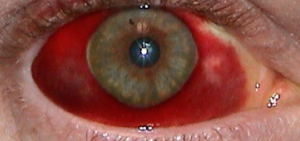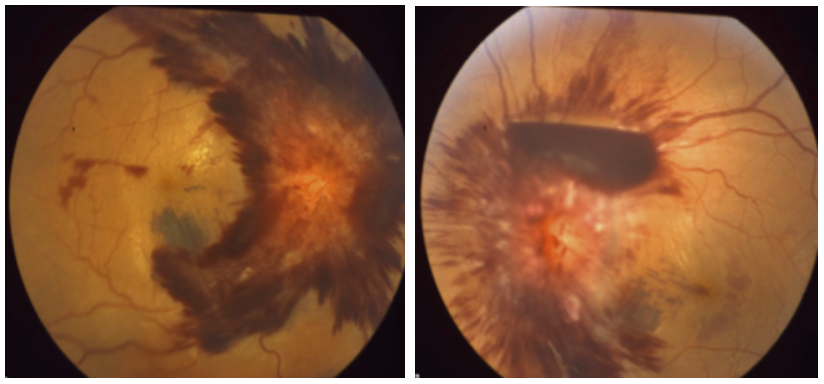
A 35 year old man presents wanting another opinion due to “blood on my right eye”. He says that everything happened 3 days ago after violently vomiting, reportedly due to food poisoning from chicken Caesar salad. He still feels a little nauseated and somewhat “not himself”. He saw another practitioner 3 days ago, was told he had a ‘bruise’ on his eye and it should go away in 1-2 weeks. From the outward appearance, he seems to simply have just a subconjunctival hemorrhage…or does he?
Further examination revealed visual acuity of 20/100 OD and 20/70 OS, certainly not explained by a subconjunctival hemorrhage. He didn’t mention anything about his vision because he was more concerned about the blood on his right eye. He then revealed headaches occurring for the past 2 weeks. Fundus examination revealed a bilateral “Blood and Thunder” appearance initially suggestive of central retinal vein occlusion…or is it
Careful inspection showed that the hemorrhages were subretinal, intraretinal, subhyaloid, and vitreous in location rather than the typical intraretinal location in retinal vein occlusion. The bilateral appearance, location of the hemorrhages, and history of headache were more indicative of Terson’s syndrome.

Terson’s syndrome originally was defined by the occurrence of vitreous hemorrhage in association with subarachnoid hemorrhage. Terson’s syndrome now encompasses any intraocular hemorrhage associated with intracranial hemorrhage and elevated intracranial pressures.
Intraocular hemorrhage includes the development of subretinal, retinal, subhyaloidal, or vitreal blood. The classic presentation is in the subhyaloidal space. This fundus appearance in the context of severe head injury should alert clinicians to the possibility of a traumatic intracranial bleed. In the absence of head trauma, headache could be indicative of a pre-existing ruptured intracranial aneurysm.
This patient was sent directly to a hospital emergency room due to the high suspicion of intracranial hemorrhage and elevated intracranial pressure, which was subsequently confirmed with MRI. Ultimately, he was diagnosed with Hairy Cell Leukemia and cryptococcal meningitis
